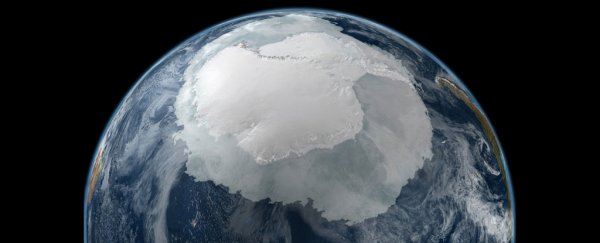For decades, scientists have puzzled over why the southernmost waters in the world were becoming less salty, and now it looks like we might have an answer.
Scientists have found that the Southern Ocean – which surrounds Antarctica – has been experiencing an increase in sea ice, which is slowly drifting northwards. When this saltless sea ice melts back into the ocean and into warmer northern seas, it freshens the saltwater around it, reducing its salinity.
According to a new study led by researchers at ETH Zurich in Switzerland, this cold fresh meltwater enters the ocean at the sea ice periphery. It then sinks below the warmer surface waters, forming what's called the Antarctic Intermediate Water.
At depths of around 600 to 1,500 metres (1,969 to 4,921 feet), this low-salinity water then spreads, extending as far northwards as the Equator, and reaching as far as the Iberian peninsula in the eastern Atlantic.
Scientists previously thought the phenomenon might be due to increased rainfall over the Southern Ocean, but the new study's authors disagree.
"Research conducted over many years has shown that the Antarctic Intermediate Water has been freshening strongly," says environmental physicist Nicolas Gruber.
"But the changes in rainfall reconstructed in the weather and climate models are far too small to be able to explain the observed freshening. It must be the increased northward transport of freshwater by the sea ice that is largely responsible for this change."
While the researchers are confident about what's driving the freshening, they're less sure about what's driving the expansion in Antarctic sea ice in the first place. But it's definitely happening – unlike on the other side of the planet, where sea ice in the Arctic is shrinking.
As you can see in the image above, Antarctica is now surrounded by a massive sheet of this sea ice. Unlike the continental ice that makes up glaciers and ice shelves – and which can be hundreds or thousands of metres thick – sea ice is only a few centimetres thick, forming when cold surface waters freeze.
When the freezing happens, the salt in the seawater is rejected, meaning the salinity in the surrounding seawater actually increases. But the more significant effect occurs when the sea ice then melts, and those now-saltless waters spread into the surrounding ocean.
As the Antarctic sea ice is growing, it has more ice to melt, which is what's creating the freshening. In the Arctic, which is losing sea ice all the time, it's possible that the reverse process is happening.
The Antarctic sea ice melts and refreezes each year, and at its maximum extent, the massive sheet surrounding Antarctica now covers around 18 million square kilometres (7 million square miles), which is about the combined land area of the US and Canada.
The researchers calculate that the sea ice increased in area by up to 20 percent between 1982 to 2008, which they suggest could be due to increased wind activity in the area, although nobody knows for sure.
"For the first time, we have been able to quantify these changes, which are presumably caused by stronger southerly winds during this period," says one of the team, Alex Haumann.
But there's also the possibility that the wind changes could be natural atmospheric variations, or an unexplained side effect of human activity, such as greenhouse gas emissions.
"This is something that we are currently not really sure of, and there's arguments that are in the one direction or the other," Haumann told Chelsea Harvey at The Washington Post.
As for what the ultimate environmental implications of freshening seawater could be, that's also up for debate – and we also don't know if this trend will continue, or it's just a temporary blip.
When water becomes lower in salinity, the salty parts of it sink to the bottom – a process called stratification – and the overall water mass becomes more stable. While this makes water less capable of absorbing heat, there could be one upside.
"A more stable stratification could theoretically lead to a stronger uptake of carbon dioxide by the Southern Ocean, because less deep water that is rich in CO2 rises to the surface, where it releases carbon dioxide to the atmosphere," Gruber explained in a press release.
We won't know more about what the effects will be until scientists have a chance for further study – but the answers, when they come, could be of the utmost importance.
"In the past we have given far more attention to the sea ice changes in the Arctic because it is shrinking so dramatically," says Haumann.
"In the long term, however, changes in the Antarctic could be far more important for our climate, as they have a major influence on the planet's surface heat balance and the atmospheric carbon dioxide levels."
The findings are reported in Nature.
